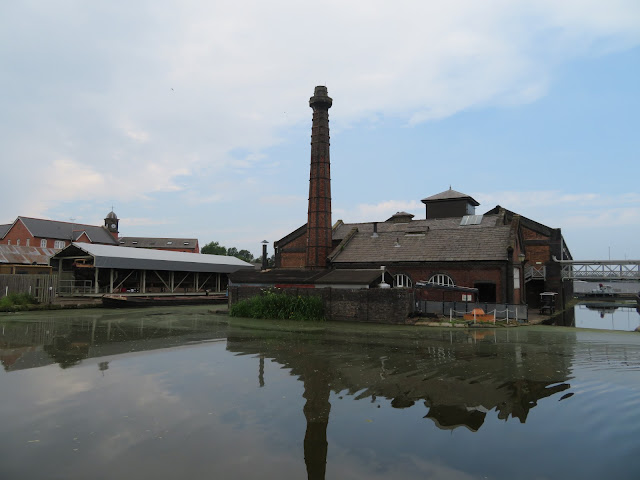We had another last look around the Boat Museum to make sure we hadn't missed anything before we set off after lunch.
I think that this would be our first narrow lock of the year, but of course they weren't to last. The wide beam locks are right next to the narrow locks.
Helen had help from a family on a visit. We learned that despite having the cross over between the two pounds above the bottom locks you should ensure that the top gate of the bottom lock is closed before lifting the paddle of the top lock as the actual top of the coping stones is lower than that of the middle pound and it floods, despite the cross over being opened. You can see the paddle for the cross over between the two pound behind the right hand beam.
We wanted to fill up with water so we tied up alongside the trip boat as the tap is just inside the museum fence. It is accessible with a Waterways key. I suppose we could have spun it round and gone st'bd side to the wharf but it seemed easier to use the boat as a fender. The last rubbish was taken to the skip near the car park and we were off. It certainly seemed ages since we had been on a 'proper' canal.
The chimney is part of the pump house and two boilers that worked the port when in action. Behind is the main exhibition space. Whilst it didn't seem to be too busy there was a steady stream of people looking round, and the cafe was busy with many cyclists using it as a stop over.
As we leave the Boat Museum we were pleased to see that the areas around the canal had been kept clean. The last time we were there we spent an afternoon cleaning up the rubbish immediately round the tow path and collected about 4 bags. It is seems to be in hand now. There was plenty of evidence of the industry that was supported by the dock and canal. I think there was a timber yard and a steel works close by as well as oil based chemical and additive producers.
There is a view of Stanlow Oil Refinery from the canal and it is a large site, the second largest refinery in the UK, after Fawley, near Southampton. It first started in 1924 as a bitumen works and was developed by Shell who sold in in 2011 to Essar for £814 million. They plan to extend it. The crude oil comes to them from Tranmere jetties on the Mersey. It's products are distributed via road, rail and ship as well as via the pipeline system that covers the country.
Helen got excited when she heard a prop driven plane overhead and recognised the WWII fights Dakota. It obligingly turned and swooped over head again so I could get a photograph.
We moored up in the countryside with good views, close to Bunbury and got on with a few jobs that were outstanding. This pigeon settled on the gate opposite and was reluctant to move, even when approached. Is this one of the baby pigeons that people claim to never have seen? It certainly didn't seem to be a competent flier.
We were moored close to Stoak and had a view of St. Lawrence's Church. The present church dates from a rebuild in 1827, although a church had been built soon after the Norman Invasion. It was in ruins by the 14th Century. Despite the fabric of the church been fairly 'new' the parish records go back, but for a short break, to 1543 and the Churchwardens accounts as far as 1677. They also have some old bells in the tower too, 1615, 1631 and 1642! The Parish Name had been Stoke but this was altered in 2015 to the same as the name of the village and to avoid confusion with the parish of Stoke in East Cheshire.
The Bunbury Arms was a nice haven on a beautiful warm day. there was a good selection of beers and the food looked very good and sensibly priced too. Well worth a walk from the canal. There are many memorials to the Bunbury family in the church, hence the name. Bunbury, the village, is the other side of Chester so we will be coming to it forthwith.










No comments:
Post a Comment